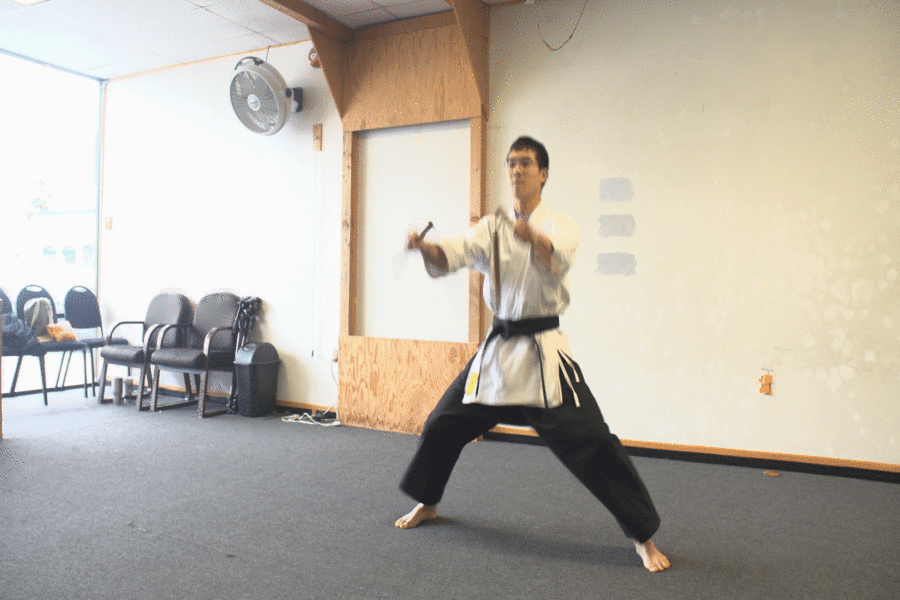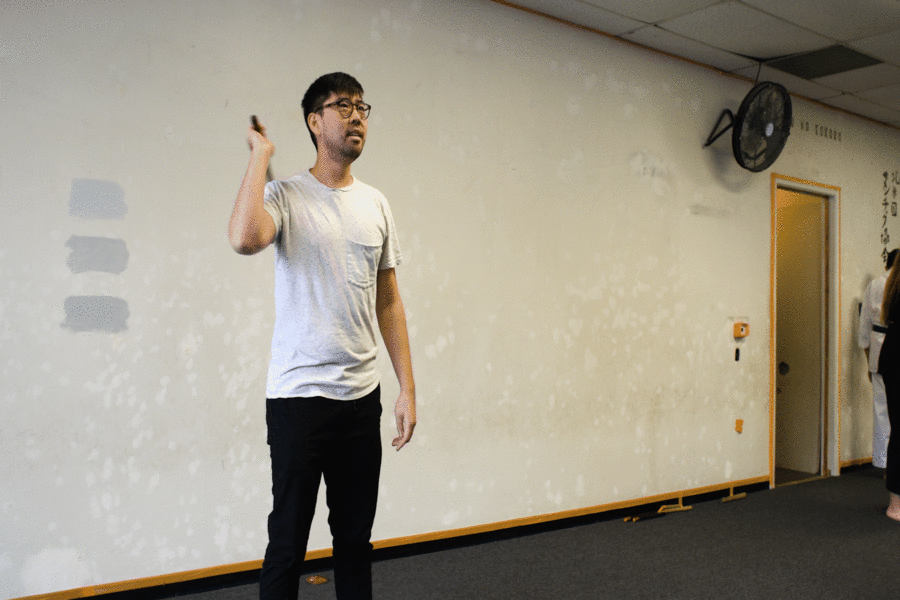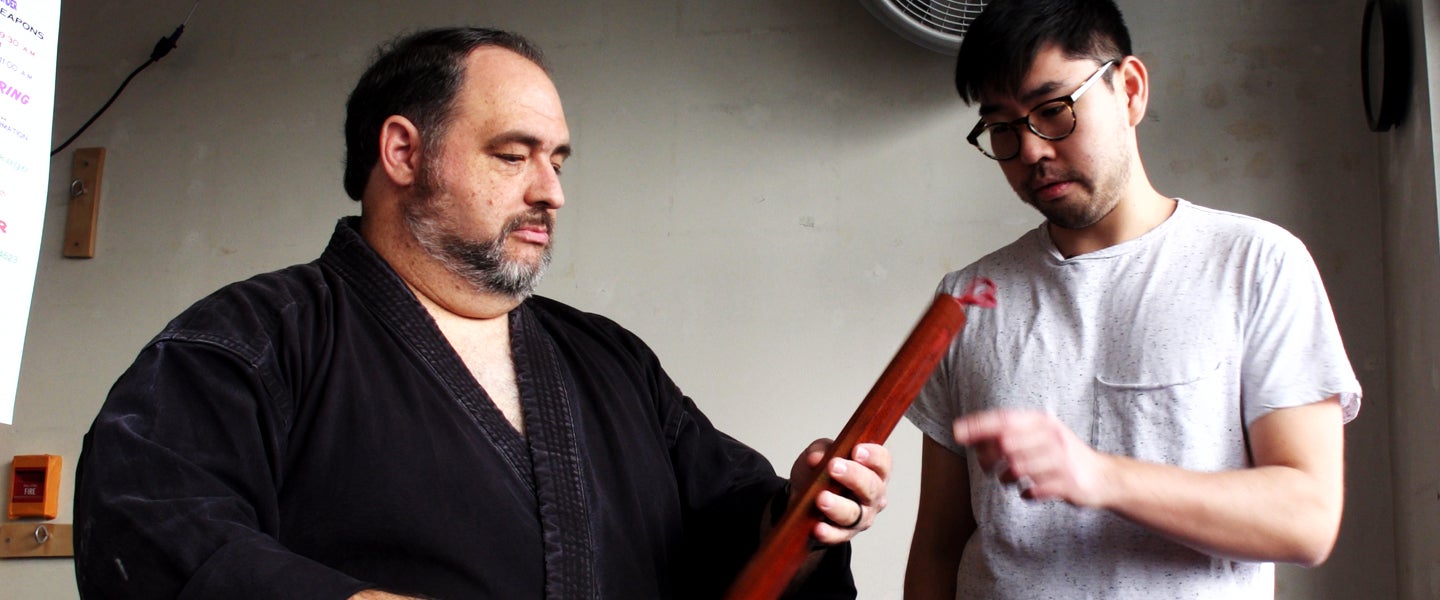“There’s a reason why we don’t fool around with foam-padded nunchucks or ones made out of plastic. We want to teach a respect of the weapon. And that means getting hurt once in a while.”
Chris Pellitteri smiles as I fidget with the nunchucks in my hand. He’s a boulder of a man, one who has spent the better part of his life perfecting his skills in karate — the black belt around his waist is so worn that the color is peeling off. He’s also a nunchaku expert who has developed his own system and runs the North American Nunchaku Association. In other words, I’m in pretty good hands for my first-ever session with a pair of nunchucks.
It’s a damp, cloudy day in the California suburb of Upland, about an hour away from Downtown Los Angeles. Pellitteri’s dojo occupies a space in a strip mall near a Vietnamese restaurant and a bong shop, and the minimalist room downplays the fact that one of the country’s foremost nunchaku experts holds court here. About 10 students have made it for the weekly Saturday nunchaku class, where they practice individual moves, learn choreographed forms and play games that develop their accuracy with swinging strikes.
It’s mostly young teens, although a few older men also take part. I assumed that, in 2019, nunchucks were a niche thing only cherished by devoted martial artists, and I dunno, anime geeks? But what Pellitteri’s noticed in the last decade is that younger generations are still falling in love with nunchaku, and pushing the discipline to new innovation. The problem is that in California, nunchucks are banned anywhere except inside a dojo, complicating matters for those who want to train outside of the hour-long class. He’s petitioning to change that, with hopes that the current interest in this old-school weapon will bloom further.

I practiced Taekwondo in my adolescence and later spent a few years pursuing Kendo, the martial art of Japanese sword-fighting, so I wasn’t quite intimidated by the challenge of flinging some nunchucks around. And for a while, it feels like I’m a low-key natural. Pellitteri shows me a sequence dubbed, simply, 1-2-3-1-2, where I whip the sticks around my head and down to one hip, then to the other, over my shoulder and back again. It’s tricky to try and remember what move comes next, but I’m swinging confidently, feeling the sting of the nunchucks on my skin and playing with the momentum that powers each spin. The ridges of the mahogany sticks feel at home in my hand.

Then I try to juice a swing around my head, and THWACK! The end of the nunchuck careens off my forehead, barely missing my glasses and falling to limpness as I wince. I think I made Pellitteri jump, and I laugh as the red-hot pain fades. “You’re going to hit yourself hard enough to tear up a thousand times before you’re good at it. I can’t remember all the cuts and bruises I had,” Pellitteri tells me, smiling after he confirms that the cocky new guy is all right. “It’s part of the learning experience. You have to pay for it.”
I’ve been aware of nunchucks as long as I can remember, but to be honest, they’ve come across more like a novelty (or a prop for infamously dorky internet videos) than a serious weapon worth learning. Hitting myself in the face changed that, as did seeing and talking to men who are masters in this surprisingly modern craft. Bruce Lee may have been the biggest influence in bringing nunchucks to the American consciousness, thanks to films like Enter the Dragon and Game of Death. But that was just the starting point for Americans like Pellitteri who have helped shape and define a foreign weapon cloaked in myths and lore.
Historical martial arts experts seem to agree that the modern nunchuck was developed on Okinawa, the island nation that was known as the Ryukyu Kingdom before its annexation by Japan in 1879. But there’s disagreement on whether the discipline was birthed by islanders or by Chinese warriors who were fleeing persecution from their country, as well as the class of the people who wielded early nunchucks.
One widely espoused theory is that the nunchucks were originally just modified agricultural flails — a tool with two pieces of wood connected by a chain, used to beat grain off stalks — that were used by poor farmers to fight Japanese samurai. This is a romantic idea, though one that makes little historical sense: Okinawan farmers were often poor and overworked in the 18th and 19th centuries, leaving little time to develop nunchaku skills, martial arts researcher Alex Levitas says. Instead, nunchaku may have been the tool of Okinawan nobles, who were slowly stripped of their rank (including swords and other formal weapons) under Japanese rule in the 19th century. The loss of their status and weapons made them more vulnerable to attacks from poor farmers and thieves, motivating these former nobles to learn skills with easily concealed, powerful improvised weaponry, Levitas argues in his research.
This early Okinawan nunchaku style would have focused on practical defense techniques, like footwork to keep opponents at striking range and whipping blows to the face and hands. But very little of this training exists in a historical record, and unlike more ancient Chinese kung-fu disciplines or even Okinawan karate, the traditional techniques and kata, or choreographed routines designed to hone individual moves, aren’t accessible.
Perhaps that’s why the influence of pop culture, as with those Bruce Lee flicks that hit the American mainstream in the 1970s, have had such an outsized impact on the growth of new nunchaku styles. Lee himself was introduced to the weapon in 1964 by his protegé Dan Inosanto, a Filipino-American hailing from Stockton, California. “At the time, he thought it was a worthless piece of junk,” Inosanto says in the 2012 documentary I Am Bruce Lee. “But in three months, he was swinging it like he’d been doing it for a lifetime.”
More dedicated nunchaku experts today take issue with Lee’s technique in those old movies, but of course they can — the martial art has undergone a transformation in the last 40 years. Some people prefer the old-school practicality taught by masters like Shihan Nishiuchi, who studied in Okinawa. There are the flowing “freestyle” techniques created by pioneers like American Grand Master Lee Barden, which incorporate flashy rolls and throws that flow so fast it’s hard for your eyes to keep up. There are police systems that cut down on the variety of swings but add a heavy dose of joint locks and other painful pressure-point maneuvers. And there are a million other styles within this spectrum, many of it defined in the late 20th century by American men who felt the freedom to experiment in a way they couldn’t in other martial arts.
Michael Burke was just 20 when he first encountered a pair of nunchucks in his hometown of Richmond, Virginia, about six months after he began training in karate. This was 1973, and back then, you had to know someone to actually learn how to use nunchucks, and a lack of knowledgeable teachers meant little choice when it came to picking a preferred style. Burke had a teacher, but he struggled to pick up some of the old-school moves and didn’t understand the purpose of others. Armed with just the basics, Burke decided to make up his own techniques instead.
“I spent a lot of time practicing, trying new things, honing moves and how they fit together. I ended up winning three state championships and about 15 other nunchaku events around the state of Virginia,” Burke, now 65, tells me over the phone. “It was just ridiculous forms I was performing, at my peak in 1976 or 1977. I retired from competition in 1978, but in 1990, my brother and I got together and started talking about putting some of these forms on a tape so that other people could learn.”
A little older and wiser by this point, Burke saw that he could take his “ridiculous” moves and actually create a training system that made sense. Flowing fast was important, but Burke also wanted the basic moves to work in self-defense. “Hopefully you don’t have to fight with them, but it is a weapon, and it should be capable as a weapon,” Burke says of nunchucks.
He dubbed the 30-minute tape “Chakus,” and cut a deal with the giant martial arts distributor Asian World of Martial Arts in Philadelphia: If the initial batch of five videos sold, the shop would order more, but if they stagnated on the shelf, the deal was off.
Burke didn’t have to wait long for proof that he was onto something. He sold dozens in the first year, and then hundreds in year two. “People were coming into the store just wanting to learn nunchaku, and they’d say, ‘Look at Michael Burke’s video, it’s pretty good.’ Most of the buyers had an interest, but they didn’t know where to go from there,” he says.
Another instructor asked for more techniques and footwork ideas, so he made “Chakus 2.” Then came “Chakus 3, 4, 5 and 6,” all helping to define and codify what Burke called “American-style nunchaku.” Burke estimates that he’s sold 21,000 copies in total, though sales have now slowed to a trickle as people uploaded more of the content to the internet.
Burke practices racquetball more than nunchaku these days, though he still enjoys flowing through his old moves on occasion. And, out of habit and faith in the system he’s created, he keeps a 12-inch pair of nunchucks right by the bed. “It wouldn’t be good against a gun, but I feel confident that if it was one or two guys — maybe even three — I wouldn’t have any trouble using them to protect myself,” Burke says with a slow, wry laugh.
The irony is that the explosion of interest in nunchucks in the 1970s also stirred up questions about the deadliness of the weapon, especially in the hands of street gangs and small-time criminals. This was myth, not reality, but the moral panic led to bans in California, Arizona, Massachusetts, and until recently, New York.
Jim Maloney first encountered nunchucks as a teenager in New Jersey in 1974, while studying karate, much like Burke and Pellitteri. Practicing nunchaku became a normal routine for Maloney and his friends at SUNY Maritime School, and it remained a passion project as he worked as a merchant marine and later bought a home in New York. “The state ban was enacted in 1974, but I didn’t really understand that I could be punished just for having them in my house,” Maloney says.
Then, in 2000, Maloney had an argument with a telephone company worker who ultimately claimed to the police that he had brandished a rifle (it was actually a telescope, Maloney claims). The police arrived at the home, demanding a search. Maloney, by that point a practicing attorney, refused. A low-pulse standoff ensued, but after 12 hours of staring at police, Maloney relented. The police never found a rifle. They did, however, pick up a pair of nunchucks from beneath the couch.
The incident resulted in a misdemeanor violation for Maloney, but the hassle energized him into questioning the merit of the ban altogether. He filed a constitutional argument against the ban in 2003, and 15 long years later, a federal judge finally struck the ban down on December 18th, stating that nunchucks should be allowed in New York under the Second Amendment.
“As a lawyer, I looked back on it and saw they just kind of took a few isolated incidents of people doing bad things with nunchaku and said, ‘Oh, well let’s ban the weapon entirely,’” Maloney says. “And it outraged me that they would be so quick to ban something that has legitimate usage in the martial arts and legitimate use for self-defense. Whereas if it were a baseball bat, well, everybody can have a baseball bat. That’s the American thing, right? Baseball. But people get killed all of the time with baseball bats!”
Even when he couldn’t own nunchucks, Maloney made it a habit to practice “shadowboxing” with imaginary sticks in his hand as a workout. He’s now finally re-strung the nunchucks that he cut in two and kept after being slapped with the misdemeanor. “I can move forward again in a part of my life that’s been kind of rested and held up for a couple of decades, really. Almost 20 years,” he says. “It feels great to be able to do that.”
Down the East Coast, Henry Bowman, a 49-year-old in Harrisburg, Pennsylvania, has already felt reverberations from the repeal of the New York ban. He’s the owner of USA Nunchaku Co., a family-owned business that makes nunchucks by hand. Bowman has been selling these nunchucks since 1998, but he hasn’t experienced a rush of holiday orders quite like the one a month ago. Streams of people began calling in after hearing news that the ban was lifted, he says. “People were basically going, ‘Oh my God, I forgot all about nunchucks.’ And they were ordering them even though they weren’t studying martial arts, in many cases. There’s a huge segment of customers who saw the news and remembered nunchucks from their childhoods, and now they want to just spin ‘em and have fun, what we call freestyle,” Bowman says.
Overall, he’s seen a major swell of orders in the last four years, and he thinks the momentum can continue. Martial arts practitioners and teachers are drawn to USA Nunchaku Co. because their nunchucks are handmade and customizable, rather than cheaply constructed and shipped from overseas markets. Bowman also sees potential for more casual nunchuck users, like an old man in the Bronx that recently bought 20 pairs.
“He uses it as a workout, because he doesn’t like the gym. He just likes to go out to the park and swing ‘em when no one is around. Or get a flow going in his house. And just having fun with it is something we encourage,” Bowman says. “Younger people and older people alike are using them for aerobic exercise, unrelated to a combat art. In fact, it’s very rare that I’m confronted by a customer who wants to use it for self-defense or as a concealed weapon. Which would be very stupid to do, anyway.”
It’s pretty obvious in talking to some of the younger people in Pellitteri’s Upland dojo that the achievement and physical sensation of spinning those sticks smoothly are what make nunchaku so addictive. Stevie Reyes, a 23-year-old black-belt instructor alongside Pellitteri, has practiced for years and now shows off wicked talent with nunchucks in both hands, whipping them off his body and around his head with precision and speed. “Karate emphasizes powerful strikes while nunchaku is more about balance and flowing and hand-eye coordination. I think they work well together,” he says. “But it’s also just that it’s a really fun weapon to get to know. It’s rewarding to work on the challenge of being able to control something that can be so unstable.”
It’s a similar case with fellow practitioner Markus Nguyen, 16, who is one of the most talented teenagers in the dojo. “I fell in love with nunchucks just through seeing it in Jackie Chan films and stuff like that. There’s just something so cool about the way the weapon is portrayed. And when you get into the groove of using nunchaku, you feel like you’re pulling off something special,” he says.
At the end of my day as a nunchaku newbie-in-training, Pellitteri disappears into a back room and reemerges with an enormous metal briefcase. Inside are nearly two dozen nunchucks, each with a unique aesthetic and story. There’s the gaudy red-white-blue “freedom chucks,” and a pair of chubby steel ones that telescope to full length with the fling of a wrist. There are rounded Chinese-style nunchucks and an oversized pair that could probably break a forearm in one swing. Then there’s the pair made of pricey African ebony, tougher than nails and silky smooth to the touch. “I love these,” Pellitteri says while handing them to me.
Many martial arts can feel punitive in their deep, respectful ties to tradition, but this briefcase of rope, chain and wooden sticks reflects how weirdly individualistic the discipline of nunchaku can be. No matter what kata or techniques you memorize and practice, you can’t help but flow differently from the guy swinging next to you. Even if everyone eventually hits themselves in the face.

